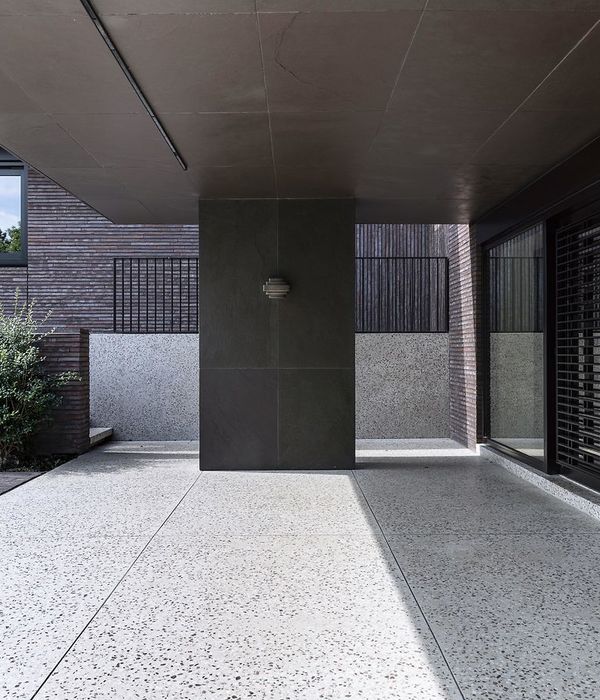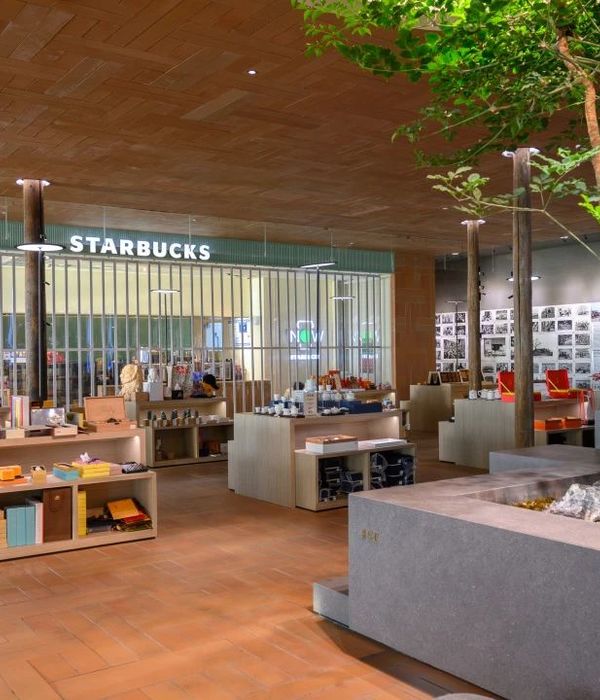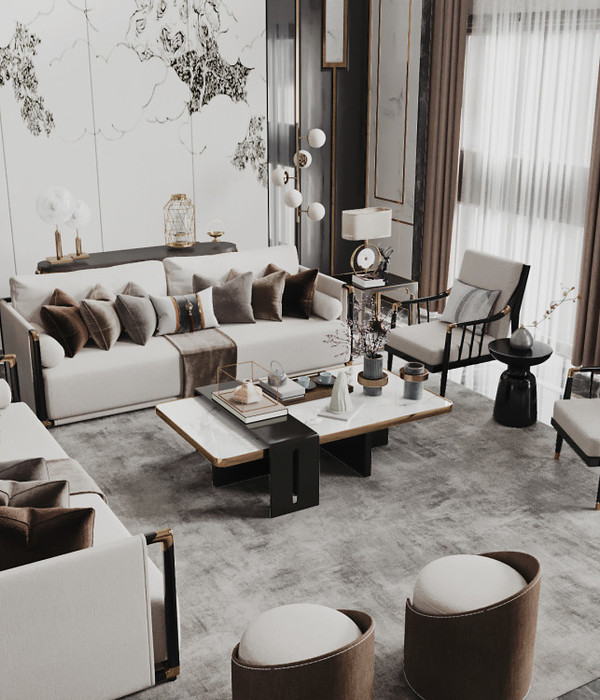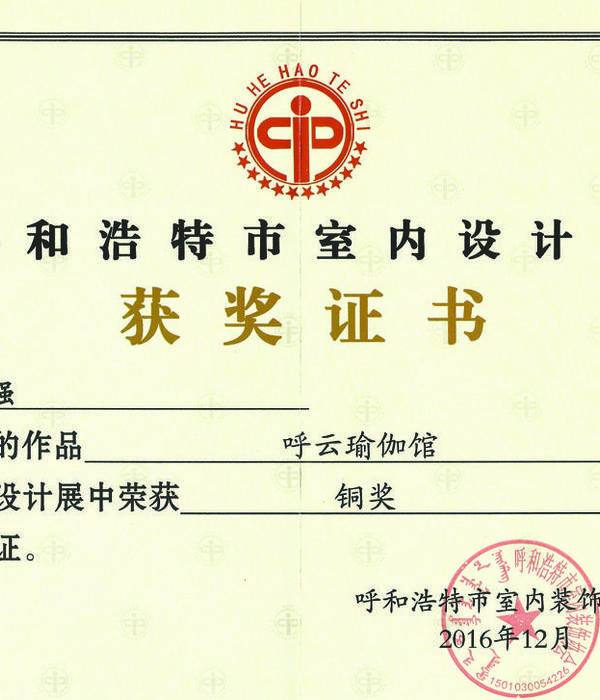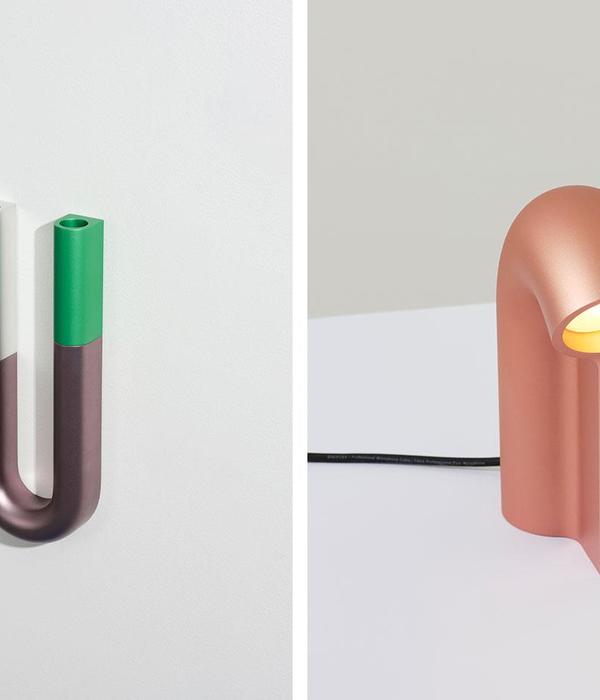MoDusArchitects 于近期完成了诺瓦塞拉修道院新入口和博物馆综合体的扩建项目。诺瓦塞拉修道院于 1142 年成立,坐落在 Eisack 山谷(意大利布雷萨诺内附近)的一处被葡萄园包围的场地。它不仅是南蒂罗尔在当今最重要的建筑群之一,同时也是其所在年代极为杰出的奥古斯丁修道院建筑。修道院建筑群就像是一个自给自足的小村庄,其中的每一栋建筑都发挥着特定的作用:选民教堂、小礼拜堂、磨坊、车间、酒窖和农舍共同形成了显著的核心——其中一部分被改造成了后来的博物馆。
MoDusArchitects presents the new entrance and extension to the museum complex of the Novacella Abbey. Founded in 1142 and nestled within the vineyard lined basin of the Eisack valley near Bressanone (Italy), the abbey not only represents one of the most significant architectural ensembles in South Tyrol today, but also stands as a preeminent Augustinian Abbey of its time. Like a small, self-sufficient village, each building within the monastery complex played a specific role: the constituent churches, chapels, mills, workshops, wine cellars and farmhouses formed an indelible nucleus—only a portion of which has been converted into a museum.
▼项目概览,general view© Simone Bossi
▼博物馆新入口,view to the new museum entry© Simone Bossi
"新增的建筑有助于引导游客进入修道院的场地并参与到其富有层次的历史当中,在尊重过去与未来建筑语言的基础上,提出新的立场和词汇。"——MoDusArchitects 联合创始人 Matteo Scagnol
"Our new addition helps orient visitors to the Abbey grounds and participates in its layered history, positing new positions and new vocabularies with an architectural language respectful of both the past and the future." — affirms Matteo Scagnol, co-founder with Sandy Attia of MoDusArchitects
MoDusArchitects 的加建方案为旧建筑置入了新的功能,并重新建立了附属结构与修道院主体建筑之间的关系。从外部看,增建的部分只能从黑色的镀铜连桥结构上被感知到,该连桥被置入重建后的服务建筑群中,使这些建筑在顶层与主修道院相连接。
MoDusArchitects’ addition injects new functions into old buildings and rewires the relationships between the ancillary structures and the main buildings of the Abbey. From the outside, the project is only evident by the blackened, copper clad bridge that emerges from a cluster of reconstituted service buildings that connect to the main cloister at the upper level.
▼黑色的镀铜连桥结构连接了重建后的服务建筑群与修道院主体© Simone Bossi the blackened, copper clad bridgeemerges from a cluster of reconstituted service buildings that connect to the main cloister at the upper level
▼连桥近景,the bridge© Simone Bossi
▼连桥一瞥,a glance to the bridge© Simone Bossi
该项目对与修道院 17 世纪翼楼毗邻的三座附属建筑进行了干预,并同时涉及了拆除、翻新和修复工作。第一座建被打通并清空内部,使原本的农用仓库变成一个通透开阔的双层高入口中庭,其中包含一个能够俯瞰风景的夹层空间。第二座建筑在拆除旧盥洗室的基础上建造了大型楼梯和升降机塔,并与修道院历史最悠久的翼楼相连。第三座建筑经过了翻新,在底层设置了一个研讨和活动空间,并带有一个新布置的户外庭院;二层是临时展览空间和唱诗班房间。
▼剖面图:本案对修道院的三座附属建筑进行了干预© Simone Bossi section:the project intervenes in three secondary, adjacent structures
▼建筑外观,exterior view© Simone Bossi
▼室内活动空间,activity space© Simone Bossi
新的入口大厅内设有定制的售票柜台、展示柜和灯具,其细部采用铜、木和玻璃相衔接的设计,与该空间新修复的木质斜屋顶的裸露屋檐和粗削石膏饰面建立起新的对话。
The new atrium features the custom-built ticket counter, display cases and light fixtures whose articulated details of copper, wood and glass create new conversations within the newly exposed eaves of the restored, pitched wooden roof and the rough-hewn plaster work.
入口大厅,entry hall© Simone Bossi
▼售票柜台,ticket counter© Simone Bossi
▼屋顶结构细节,roof structure© Simone Bossi
大厅空间,entry hall© Simone Bossi
▼座位细节,seating details© Simone Bossi
穿过入口大厅之后,游客们将来到室外空间,开启他们的修道院之旅。蜿蜒的路线穿过 18 世纪的图书馆和新修复的 17 世纪的壁画房间,最后再通过楼梯进入位于二层的加建空间,从而完成整个旅程的闭环。如此一来,MoDusArchitects 介入的部分同时成为了博物馆空间序列的起点和终点。
入口大厅望向楼梯,view to the stairwell from the entry hall© Simone Bossi
▼细节,detailed view© Simone Bossi
▼楼梯通向二层,way to the upper floor© Simone Bossi
在结束博物馆的参观后,游客将走出修道院的古老墙壁,进入新的连桥空间,并通过大尺寸的窗户获得视觉上的释放:跨越翻新过的仓库屋顶,可以判断出 Sant’Angelo 礼拜堂的方位,同时还能享受到修道院围墙花园内部以及远处葡萄园的独有视野。
▼连桥剖面,bridgesection
▼连桥内部,interior of the bridge© Simone Bossi
拥有细腻纹路的裸露混凝土墙、压光混凝土地面和厚实的栗木构件共同营造出空间的触觉背景,将空间序列重新带回倾泻而下的楼梯,从而再次进入中庭。这些建筑元素在由微妙色调与自然材料构成的氛围中保持了一致;简单而克制的设计与搭配思路,使建筑的新旧部分通过离散的细部得到调和,不论是楼梯的护栏、门窗还是地面和墙面的处理,都给人一种宁静而平和的感觉。
Bush hammered, exposed concrete walls, trowel-finished concrete floors, and thick chestnut woodwork provide a tactile backdrop to bring the spatial sequence full circle back to the cascading stairs that lead to the atrium once again. The architectural elements are held together in an atmospheric balance of subtle tones and natural materials; a sense of serenity is afforded by the measured use of a limited design palette whereby the new and old are reconciled through discrete details, be it from the parapet of the stair, the fenestration, to the finishing of the vertical and horizontal surfaces.
▼楼梯间细节,stairwell detailed view© Simone Bossi
项目中还融合了 PaulRenner 的艺术创作,他对圣奥古斯丁花园浪漫而有趣的诠释为沉静的室内空间增添了一份美妙的遐想。当游客从修道院的上层回到入口大厅时,可以看见升降机塔外壁上铺陈开的精美壁画——作为 Renner 对修道院植物的充满诗意的附注。
The project is accompanied by the artistic interventions of Paul Renner whose romantic and playful interpretations of the hortus sanctis augustini create a whimsical sidekick to the sobriety of the interiors.
Renner’s picturesque excursus on the botanical heritage of the Abbey unfolds along the metal cladding of the elevator tower as visitors descend from the upper level of the cloister back to the entry hall.
升降机塔外壁上铺陈开的精美壁画是 Renner 对修道院植物的充满诗意的附注© Simone Bossi Renner’s picturesque excursus on the botanical heritage of the Abbey unfolds along the metal cladding of the elevator tower
▼活动空间,event space© Simone Bossi
MoDusArchitects 的方案以一种独到而精确的方式回应了诺瓦塞拉修道院在不同时期的建筑特征,将历史与现代词汇融合为一个平衡的整体。空间序列的设计与感官体验、空白处传达的信息、时间的流逝,以及只有游客自身能够感受到的细微品质,这些元素将修道院包含的事物一并带向了未来。
MoDusArchitects’ work takes on the heterogeneity of the disparate architectural time periods of the Novacella Abbey with an incisive approach that melds together both historical and contemporary vocabularies in a balanced whole. The design of the sequence of spaces and their haptic, tactile messages of emptiness, time passing and the more ephemeral qualities that only the visitor can experience, carry forward all that the Abbey offers into the future.
面细节,facade view© Simone Bossi
▼窗景,view© Simone Bossi
▼模型,model© Jürgen Eheim
▼设计分析,diagram© Jürgen Eheim
▼场地平面图,site plan© MoDusArchitects
▼首层平面图,ground floor plan© MoDusArchitects
二层平面图,first floor plan© MoDusArchitects
三层平面图,second floor© MoDusArchitects
▼连桥立面展开图,unfolded elevations and roof copper clad bridge© MoDusArchitects
▼连桥剖面图,bridge section© MoDusArchitects
▼入口大厅剖面图,entry hall section© MoDusArchitects
▼楼梯间剖面图,stair hall section© MoDusArchitects
PROJECT NAME: Novacella Abbey Museum Addition
LOCATION: Stiftstraße 1, 39040 Vahrn (BZ)ARCHITECT: MoDusArchitects (Sandy Attia, Matteo Scagnol)PROJECT ARCHITECT: Laura Spezzoni
CLIENT: Augustinian Canons of Novacella; Augustiner Chorherrenstift Neustift
DESIGN PHASE: June 2016 — May 2020
CONSTRUCTION PHASE: May 2020 — April 2021
COMPLETION: May 2021
OPENING: June 4th, 2021
GFA: 300 sqm (new construction) 310 sqm (covered area building under protection)STRUCTURAL ENGINEER: Ing. Philipp Prighel, Bergmeister ITB
MECHANICAL ENGINEER: Ing. Norbert Klammsteiner, Energytech
ELECTRICAL ENGINEER: Andreas von Lutz (Von Lutz Studio Associato)GENERAL CONTRACTOR: Oberegger GmbH
EXHIBITION DESIGN: Alessandro Gatti, doc s.r.l.
ARTISTIC CONTRIBUTION: Paul Renner Hortus Sancti Augustini, Camera d’ambra
MATERIALS:- Timber construction: Hubert Silgoner- Electrical installations: MairSystem- Mechanical and plumbing installations: Abfalterer- Sheet metal work and copper cladding: Stampfl GmbH- Concrete flooring and paint finishes: Die Meistermaler- Plasterwork and wall restoration: Amac Bau- Wood and tile floors: Peintner Fliesen- Metal fabrication: Metall Ritten- Windows: Askeen- Doors: Rubner Türen- Automated doors: Doormatic- Lighting solutions: Zumtobel- Custom-built furniture: Möbel Ladinia- Standard furnishings: Trias OHG- Audio-visual equipment: Putzer- Upholstery and window coverings: Sedis GMBH
PHOTOGRAPHER: © Simone Bossi
{{item.text_origin}}




